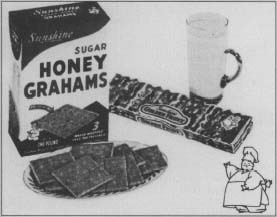 |
| From Better Living Through Breakfast |
I do not remember a single day my grandmother did not have a package of graham crackers in her kitchen. If you were hungry between meals, the choices were that or a banana. I remember asking her once why she always had graham crackers, and her response was that "they were good for children".
 | |||
| Click here to read about how they're made. |
So what was the purpose of graham crackers? Why were they "good for children", and what in the world is graham flour?
 |
| From Old Magazine Ads |
A lackluster academic career and a realization that teaching was too taxing for his weakened frame led to his choice to become an ordained minister. At first, his attention was fairly normal for a forward-thinking minister of the era; abolitionist, helping prostitutes and those sent to asylums, and discouraging corsetry. Influenced by the works of Dr. William Metcalfe, Graham was soon convinced that consumption of animal products was a carnal act, the source of many of societies ills.
One of the forerunners of the temperance movement, he spoke widely about his opinion on links between meat consumption, morality, and illness, even though his understanding of disease was very faulty(his rhetoric blamed 1832 cholera epidemic on lewd behavior and chicken pie). Meat consumption was considered the source of masturbation, a previously all but unmentioned act, which Graham claimed to cause everything from insanity to pubescent acne, leading to the societal trend of circumcision of all male children as a preventative measure, something still not done in other Western nations. His followers had a heavy influence on American Christianity, shaping mid-Nineteenth Century ideas that many Conservative American Christian movements still follow: to wear loose modest clothing, avoid eating too much meat, avoid even the most remotely sexual actions unless for procreation between married spouses, avoid tea, coffee, alcohol (essentially any drink other then cold water available during the era), drugs, and tobacco, refined sugar and flour, and stay away from doctors as much as possible. Movements from this era such as the Quakers, Shakers, Seventh-Day Adventists and Latter-Day Saints were particularly influenced.
Other then the above groups and similar organizations, Grahams ideas fell again in popularity rather quickly. As he aged, it became obvious that his diet was not improving his health the way he hoped it would, and, it would seem, returned to eating meat and died a bitter man.
 |
| From Fooducate.com |
After all of the above, Graham left one legacy outside of select pockets of Christianity: Graham Flour. At the beginning of the Industrial Revolution, it was discovered that flour could be preserved almost indefinitely by removing the wheat germ. This is because the oil in the germ leads to slightly cakey, yellowish flour that goes rancid and spoils quickly. Remove the bran and you get very soft white flour, remove the germ and that flour can stay in storage for years.
The problem is that removing all of the above also renders the flour (for all intents and purposes) nutritionally inert other then its carbohydrates. Even if he might have been off on some ideas, Graham was on to something when he realized what dieticians have been verifying ever since: That much processing wasn't healthy. Graham flour, on the other hand, finely grinds the endosperm, then adds back in the germ and bran, ground separately and slightly more roughly(unlike regular whole wheat flour). Because of this, it's best to buy Graham flour in small packages, check the date, and keep it in the freezer to prolong shelf life(also a good plan with other high-oil plant foods like nuts). Try it in recipes for whole-wheat crusty bread, sourdough pancakes, and crackers, too...it has a more nutty and sweet flavor then regular whole wheat.
In honor of this strange, eclectic man who gave us an all-American children's treat, the basis for pies, bar cookies, and smores, try making your own graham crackers. I promise they will put the store-bought ones to shame.
 | ||
| Recipe from Smitten Kitchen |
From the Cupcake Project Blog (she uses the old Fannie Farmer recipe)

3 comments:
Hi Jesse! Wonderful post, so informative!!! I did a post about Graham a while back. I just may need to dig it out and link this post to it!!!
Thank you so much for sharing...You really have a delightful blog:) Louise
Thank you!
And please do link your post! I'd love it if you left a link in the comments as well!
Now there was a strange man.
Post a Comment